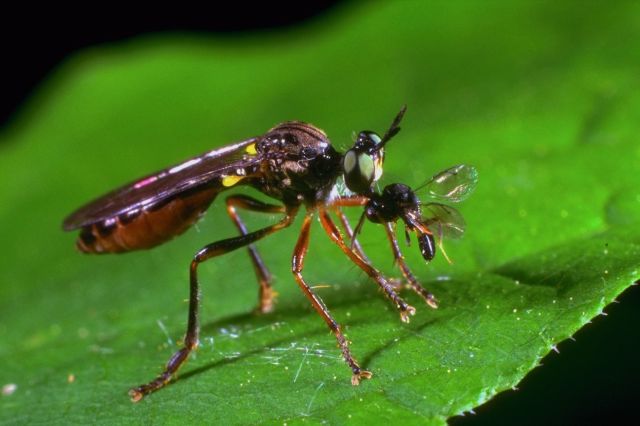

The insect nervous system (described in detail in an Appendix) consists of a brain linked to a nerve cord that runs along the thorax and abdomen. The brain is composed of three pairs of ganglia (dense clusters of neurons) located near the back of the head. Each pair of ganglia controls different activities within an insect's body. Other pairs of ganglia are found below the brain and esophagus, in the thorax and in the abdomen. Internal organs are controlled by a separate nervous system (Meyer, 2002).
An insect's nervous system is much less centralised than that of a vertebrate. In an insect, most overt behavior (e.g. feeding, locomotion, mating, etc.) is integrated and controlled by segmental ganglia instead of the brain. The brain may stimulate or inhibit activity in segmental ganglia, but these signals are not essential for survival. Indeed, a headless insect can survive for days or weeks (until it dies of starvation or dehydration) as long as the neck is sealed to prevent loss of blood (Meyer, 2002)!
Shaw (2002) makes a similar relevant observation:
It is tempting to assume that all animals are like us and "think" with the cephalic ganglia. In fact many invertebrates are co-ordinated by their closest ganglion, with the "brain" sending higher level commands such as targeting food or avoiding danger, while the muscles co-ordinating legs / body wall muscles work autonomously.
The significance of these remarks is that they alert us to the possibility that mental states may not be associated with a single master organ in the body. There is no a priori reason why "having a mind" should not be a distributive property. If this is the case, then insects' mental states (if they have any) cannot be adequately described by looking at body parts in isolation; the ensemble also needs to be investigated.
For instance, leg withdrawal can be conditioned in headless cockroaches or in isolated leg and thoracic ganglion preparations. The thoracic ganglion is a much more complicated cluster of nerves in the cockroach than the brain (Kentridge, 1995). Cockroaches are thus capable of "distributed" learning. This example should make us wary of arguing that an animal lacks mental states because its brain is too primitive. "Simpler" animals may think with their body parts, instead of their brains.
Nevertheless, the nervous system of an insect is still much simpler than that of vertebrates. Differences between the brains and central nervous systems of vertebrates and different phyla of invertebrates are discussed in an Appendix.
Back to Insect page Next page References